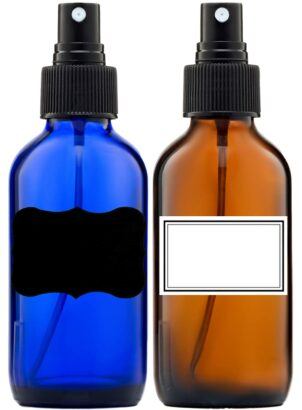Summer is gone, but it doesn’t mean that fleas and ticks are as well. It’s important to keep your precious pups protected. Here are some easy directions for homemade flea and tick sprays using essential oils. Some of them will work for you, too! For your convenience, we have included Amazon links to everything you will need to make these.
You may have read about the pros and cons of using essential oils on our doggies. Just remember this. Because they are natural does not mean they are safe. So please do your research regarding essential oils for your pets, as I have. For instance, many essential oils, such as citrus, eucalyptus oil, tea tree oil, cinnamon, pennyroyal, peppermint, pine, sweet birch, wintergreen, and ylang-ylang are toxic to pets. These are toxic whether they are applied to the skin OR used in diffusers.
Our recipes for homemade flea and tick sprays include only SAFE essential oils to use on your dog, and we’ve included links to everything you would need. Just keep in mind that you must ALWAYS dilute essential oils before using them on your pet. And because our pets have an extremely heightened sense of smell, it’s always best to let them have a little sniff from afar before you slather it on them. If they turn their nose up at it, then do not proceed any further.
Homemade Natural Tick Repellent
This one has only three ingredients. It can’t get much simpler than that. The mysterious ingredient in this natural tick repellent is no mystery at all. It’s an essential oil… Rose Geranium. An added plus, it smells divine. Everyone in your family can safely use it, including your precious pups, both young and old. However, although Rose Geranium is a tick repellent, it does not kill the ticks. But it does make your dog far less desirable to those nasty creepy crawlers.
How to use on your doggie
Mist your dog from head to tail tip with the Rose Geranium spray, taking special precautions to avoid his eyes. You can spray some into your hands and rub carefully on his face and ears. Don’t forget his undercarriage, legs, and paws. Apply to collar and leashes and his dog pack.
NOTE: Be sure to check with the manufacturer before applying to biothane collars and leashes. If your collar and leash are fabric, then you can apply. But anything other than fabric, please check with the manufacturer.
Don’t forget to reapply as needed if you’re hiking with your pet. You’ll know when it’s time when the fragrance dissipates, usually about every four hours or so. Always reapply after swimming or puddle jumping.
Oh, and don’t forget about yourself. You only need to mist yourself from your feet to your waist. Usually, that should be sufficient. But, use your own best judgment. Also, you can spray your shoes and clothing as well. But, beforehand, always do a spot check on your clothing in an inconspicuous place. You don’t need any unwanted surprises if you’re uncertain about the fabric.
One caveat: Not all things work on all individuals the same way. Be they human or dog. You may need to adjust your amount of essential oil if it doesn’t seem to be doing the trick. It may constitute a little trial and error. But, no worries. You’ll finally master it. Just have a little patience. It will be worth it.
Additional information
No matter what tick repellent you use, be sure to check your pup thoroughly each day. Even using your Rose Geranium tick repellent spray, you might still notice a tick on your dog. But the good news is, they’re usually crawling along his fur looking for a way to escape and not looking for a way to sneak under and reach his skin. If you do happen to see the nasty creepy crawler, it’s probably because the spray has worn off or you didn’t spray enough onto his coat.
Don’t forget to reapply after his swim. And if you encounter a tick, pick it off. Usually, ticks have to have attached themselves for 36 to 48 hours before Lyme Disease can be transmitted. Don’t panic!! You have plenty of time. To remove the tick, use tweezers to grab as close to the skin as possible. Being careful not to twist, pull up with steady pressure. And don’t worry if you happen to leave the mouthparts of the tick in his skin. Just leave them as your dog’s skin will self-heal and eventually push them out. Be sure to apply an antibacterial ointment on the bite.
Supplies you will need
Dark amber or cobalt blue glass spray bottles, 4 oz.*
- Rose Geranium Essential Oil. Therapeutic grade, 40 drops.
- Witch hazel or plain vodka, 1 tablespoon
- Distilled water, 1/3 cup
*Regarding bottles: glass is the recommended container for all essential oils spray. But if you are going hiking, camping, fishing, etc., glass is not your best friend. Use either plastic (purchase HDPE plastic bottles in amber or cobalt blue) or stainless steel. For storing and using at home, glass is the preferred vessel.
Directions
- Measure the Witch Hazel or plain vodka into the glass bottle using a small funnel, if needed.
- Add 40 drops of Rose Geranium essential oil.
- Finally, add in distilled water and shake. Always shake before using it.
NOTE: Lasts up to 6 months.
If you are out walking or hiking, you can always use one of these TICK KEYS. They’re tiny enough to keep in your pocket or on his leash or collar. They’re also great for humans — your pups might not be the only one to get a tick during your walk. Ticks are not very particular as to which body they may decide to hitch a ride on. Always good to be prepared.
Homemade Natural Flea Sprays
Because essential oils are extremely concentrated, the oils MUST be blended with a carrier oil like coconut oil, Witch Hazel, olive oil, sweet almond oil, avocado oil, and jojoba oil. Coconut oil is also an effective antifungal.
Dogs don’t react the same way to essential oils, and the oil must NEVER be applied directly onto dogs as some can be toxic and/or cause chemical burns. Always be sure to keep the essential oils safely away from your pets. Your dog must never ingest them.
Using the proper essential oils, you’ll find they don’t only repel fleas, but they also help ease his itching and scratching they endure after being bitten. The oils also have antiseptic properties that aid in the healing of bites and scratches. Below I’ve listed several essential oils that both KILL and REPEL fleas.
Kills fleas
a. Cedarwood Essential Oil: heavily diluted cedarwood oil can be sprayed on a dog’s skin to kill existing fleas, plus preventing new ones from land and biting.
b. You can also use Cedarwood Essential Oil in a diffuser to protect the inside of your home. Especially great for your cabin in the woods. Used with a garden hose sprayer, it will rid your yard of fleas.
Repels fleas
a. Lavender Essential Oil diluted can be applied on a dog’s skin to repel fleas.
b. Lemongrass Essential Oil and Basil Essential Oil can be diluted and sprayed on a dog’s skin to repel fleas. NEVER apply either undiluted.
c. Rosemary Essential Oil can be added to your dog’s bathwater to provide long-acting flea repellent and soothe flea bites.
d. Rose Geranium Essential Oil diluted can be applied topically to his fur to repel fleas.
Flea killer spray
- Add 10 drops each of Lemongrass Essential Oil and Citronella Essential Oil.
- Add 1 cup white distilled vinegar.
- Add a few drops of Cedarwood Essential Oil.
- Always shake well before spraying.
- After spraying on their fur, including belly, legs, and tail, be sure to spray some into your hands to rub onto their face being careful of their eyes, nose, and mouth. Afterward, rub the remaining oil from your hands thoroughly through their fur to ensure complete coverage. Also, be sure to vacuum regularly to help keep the flea population down.
If your dog enjoys the water, whether a pond, lake, ocean or just a plain old puddle, be sure to reapply after their fur dries.
How often you use the essential oil flea or tick sprays depends entirely upon you and your dog’s lifestyle. The more time you spend at the water or in the woods, the more often you’ll need to reapply. If your pup is a couch potato, then applying once weekly should be sufficient.
Remember, if your dog is small, adjust the amounts of these ingredients accordingly. Again, it’s trial and error. Just don’t get discouraged. It’s worth the time it might take to figure it out.
Note: Please check with your vet before using the above ingredients in case your dog is allergic to any of them.




